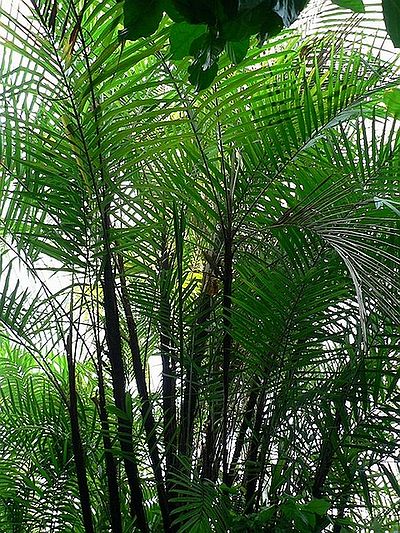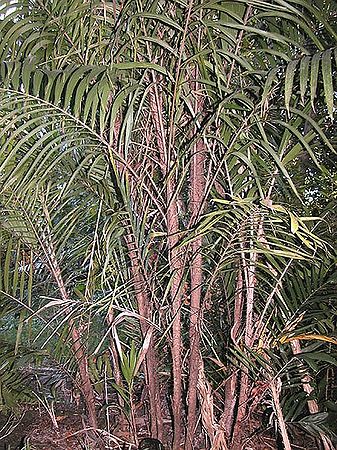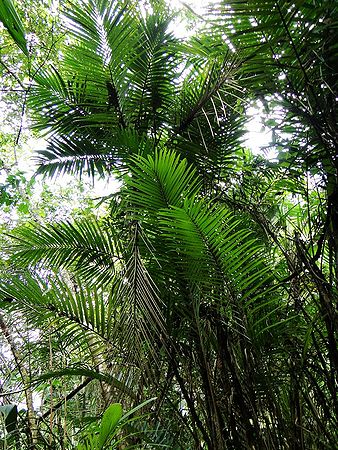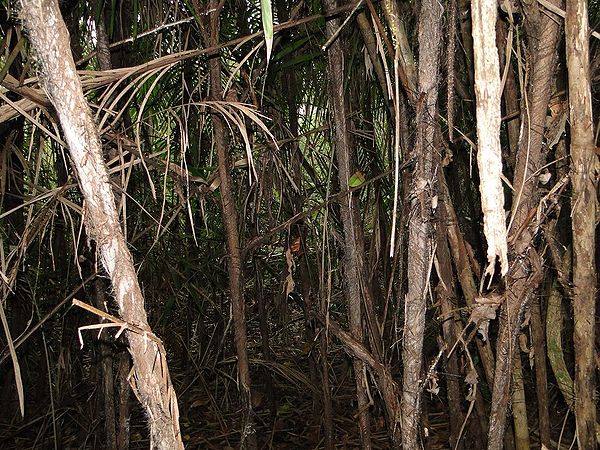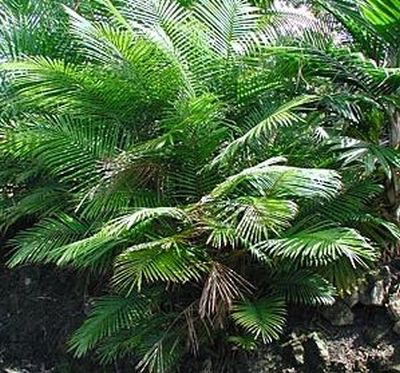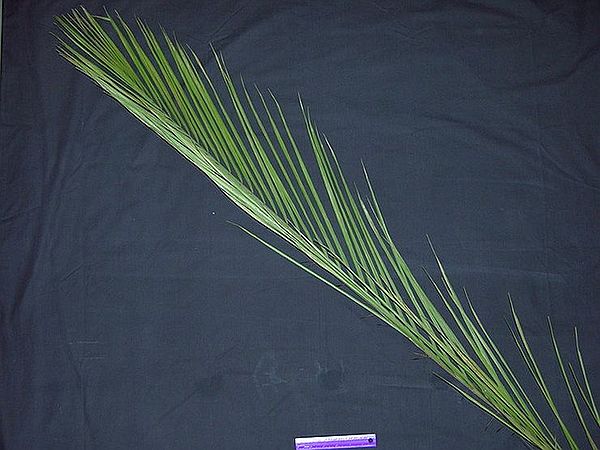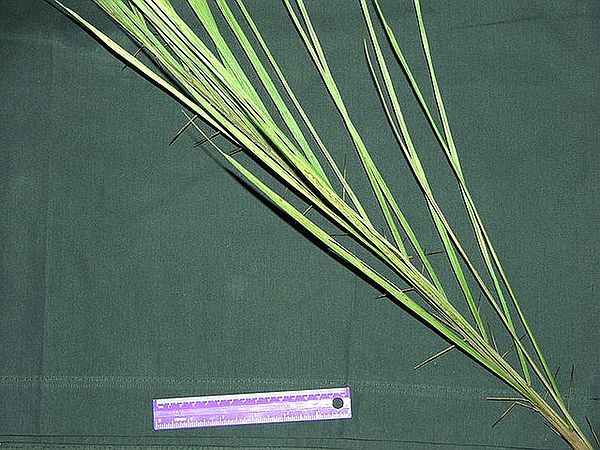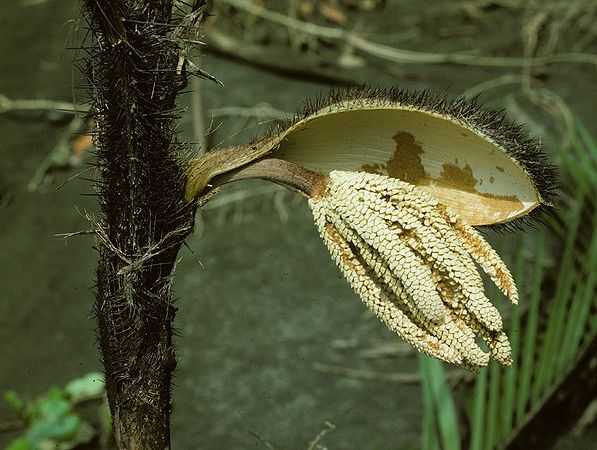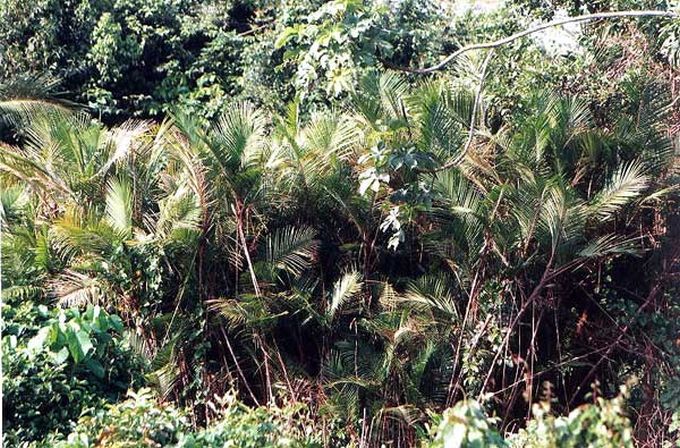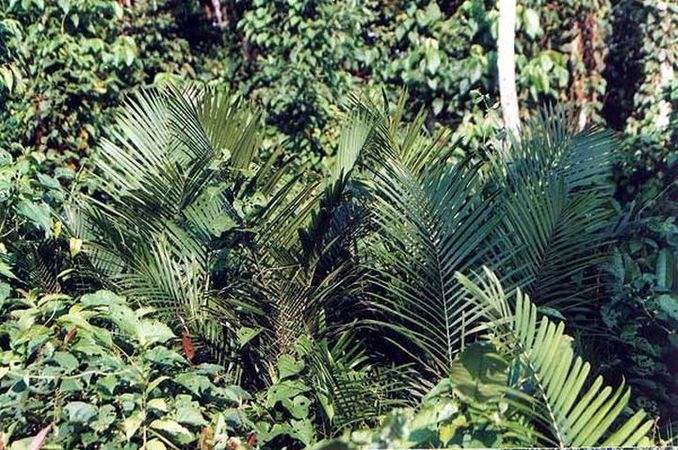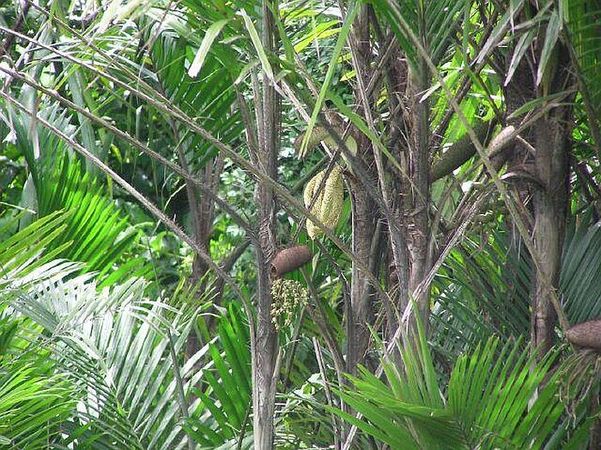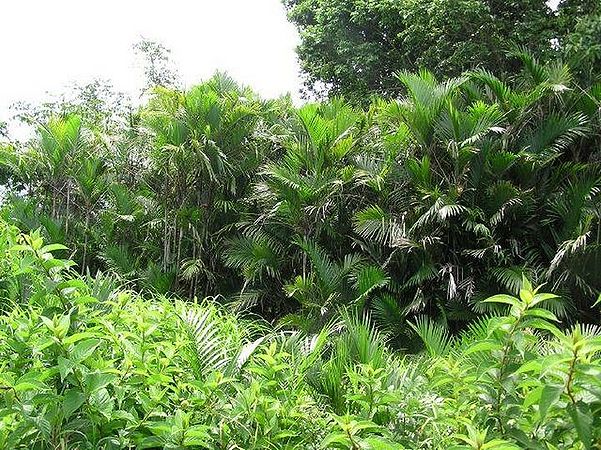Bactris major
| Bactris (BAHK-triss) major (MAH-yohr) | |||||||
|---|---|---|---|---|---|---|---|
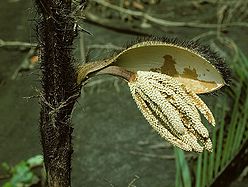 Brazil. | |||||||
| Scientific Classification | |||||||
| |||||||
| Synonyms | |||||||
|
| |||||||
| Native Continent | |||||||
|
| |||||||
| Morphology | |||||||
| |||||||
| Culture | |||||||
|
| |||||||
| Survivability index | |||||||
|
| |||||||
| Common names | |||||||
|
| |||||||
Contents
Habitat and Distribution
Bactris major is found in forests, but more often in open areas, near rivers and streams or standing water, or other places periodically flooded, often in coastal areas, also in disturbed places, below 600 m elevation, in Belize, Bolivia, Brazil North, Brazil Northeast, Brazil West-Central, Colombia, Costa Rica, Ecuador, El Salvador, French Guiana, Guatemala, Guyana, Honduras, Mexico Gulf, Mexico Southeast, Mexico Southwest, Nicaragua, Panamá, Peru, Suriname, Trinidad-Tobago, and Venezuela. Common and widespread from southern Mexico through Central America to northern South America, less common in the Amazon region, again common in lowland Bolivia. (Henderson, A.J. 2000)/Palmweb.Description
Stems solitary or clustering, but usually cespitose (growing in tufts or clumps), 1-10 m tall, 2-6 cm in diam., spiny on internodes. Leaves 3-10 per crown; leaf spines brown or black, more or less terete, to 11 cm long, moderate to dense on sheath, petiole, and rachis; sheath 22-55 cm long, fibrous on margins; ocrea to 20 cm long, becoming fibrous; petiole 0.1 -1.5 m long; rachis 0.7-1.8 m long; pinnae 24-46 per side, more or less regularly arranged, sometimes irregularly, spreading in the same plane, linear, aristate, minutely spiny on margins, with a metallic sheen on drying; middle pinnae 25-62 x 1-3.5 cm. Inflorescences interfoliar; peduncle 15-40 cm long, recurved, spinulose or densely spiny; prophyll 13-30 cm long; peduncular bract 28-60 cm long, densely to moderately covered with black, dark brown, or yellowish brown spines to 1 (-2) cm long; rachis 0.5-4 cm long; rachillae (1-) 5-10 (-17), 9-23 cm long, about 2 mm in diam. at anthesis, 3-4 mm thick in fruit, at anthesis scarcely covered brown tomentum; triads irregularly arranged among paired or solitary staminate flowers; staminate flowers 3-8 mm long, somewhat persistent; sepal lobes 1.5-3 mm long; petals 3-7 mm long; stamens 6; pistillode absent; pistillate flowers 4-9 mm long; calyx tubular, 4-8 mm long, minutely spinulose; corolla tubular, 3-5 mm long, minutely and densely spinulose; staminodial ring adnate to corolla, 1-3 mm long; fruits 1.5-4.5 x 1-3.5 cm, subglobose, irregularly ellipsoid, ellipsoid-oblong, or broadly obo-void, brown or purple-black, with minute spinules or small brown scales; mesocarp juicy; endocarp ellipsoid or obovoid, the pores equatorial, equidistant, but fertile one displaced proximally; endocarp fibers numerous, free; fruiting perianth with regularly lobed calyx shorter than the regularly lobed, swollen corolla, with staminodial ring adnate to corolla. (Henderson, A.J. 2000)/Palmweb. Editing by edric.
| read more |
|---|
|
Bactris major is diagnosed by its pistillate flowers (and fruits) with staminodial ring, subglobose, irregularly ellipsoid, ellipsoid-oblong, or broadly obovoid, brown or purple-black fruits 1.5-4.5 x 1-3.5 cm, with minute spinules or small brown scales, and ellipsoid or obovoid endocarp with the pores equatorial and equidistant, but the fertile one displaced proximally. Synonymy was established by Henderson (1995) and de Nevers et al. (1996). This is a widespread and extremely variable species. Henderson (1995) divided it into four varieties, only three of which are here accepted. This species is, however, still poorly understood, and the boundaries between the varieties are not always clear. Bactris major var. major is fairly homogeneous vegetatively, but variable in fruit size and shape. It is similar to, but easily distinguished from var. sociale, by the peduncular bract spines and geographic range. Bactris major var. infesta is even more heterogeneous. Some specimens from the western Amazon region of Ecuador, Peru, and Brazil are smaller than the others and have inflorescences with 1 or 2 rachillae (e.g., Balslev et al. 84772, Henderson et al. 1524, Henderson & Padilla 2103, Pardini 58, L. Vargas 976). Except for their swollen, scurfy or spinulose fruiting calyx and corolla and scurfy or spinulose fruits, they are similar to specimens of B. concinna, and some were so identified by Henderson (1995). One specimen (Brazil. Amazonas: Barcellos, 19 Jun 1874, Trail 855/LXII (K)), incorrectly determined by Trail as B. aristata, is similar to another specimen (Brazil. Amazonas: Mun. Careiro, km 22 on Manaus-Porto Velho hwy., 3°30'S, 60°W, 1 Apr 1985, Henderson 176 (NY)). Both are large plants with regularly pinnate leaves, inflorescences with 1 rachilla, and pistillate flowers with a staminodial ring. Both lack fruits but could belong to B. major although neither is included in the above description. Another specimen (Venezuela. Lara: Gamilotal, 2-3 km E of El Altar, 10°40'S, 69°W, 200-300 m, 17 Jun 1994, Noblick & R. Smith 4935 (FTG, NY)) has the large inflorescence and clustered leaf spines of B. setulosa, but fruits of B. major, and may be a hybrid. This specimen is similar to another, at least in fruits (Venezuela. Aragua: Maracay, 2 May 1930, Vogl s.n. (B), except that this latter has a leaf with flattened yellow spines (like B. brongniartii), and was determined by Burret as Pyrenoglyphis leucacantha (Linden & Wendland) Burret. Vogl s.n. may also be a hybrid (Henderson, A.J. 2000)/Palmweb. |
Culture
Partial shade, sandy loam soil, needs high humidity. Plant in frost free locations.
Comments and Curiosities
| read more |
|---|
|
There are three subspecies; 1.) Bactris major var. infesta, Bolivia, Brazil North, Brazil Northeast, Brazil West-Central, Ecuador, Guyana, Peru, Suriname, and Venezuela. Venezuela (Amazonas), Guyana, Suriname, Ecuador (Sucumbíos), Peru (Loreto, San Martín), Brazil (Acre, Amazonas, Maranhão, Pará, Rondônia), and Bolivia (Pando, Santa Cruz) lowland rain forest on non-flooded soils, at 140-400 m elevation. Common Name: Brazil: marajá, piri'a-hu (Ka'apor). Leaves 3-7; pinnae 24-42 per side, more or less regularly arranged, occasionally clustered, spreading in the same plane. Inflorescences interfoliar; peduncular bract 27-40 cm long, sparsely covered with black spines to 1 cm long; rachillae 1-7, 9-15 cm long; pistillate flowers and fruits usually without a "staminodial ring" between the calyx and corolla; fruits 1.5-3 x 1-2 cm, obovoid or ellipsoid, brown or purple-black, with minute spinules or small brown scales. (Henderson, A.J. 2000)/Palmweb. 2.) Bactris major var. major, Belize, Brazil North, Brazil Northeast, Colombia, Costa Rica, El Salvador, French Guiana, Guatemala, Guyana, Honduras, Mexico Gulf, Mexico Southeast, Mexico Southwest, Nicaragua, Panamá, Suriname, Trinidad-Tobago, and Venezuela. Southern Mexico, Belize, Costa Rica, El Salvador, Guatemala, Honduras, Panama, Colombia (Bolívar, Córdoba, Magdalena, Norte de Santander), the Guianas, Trinidad and Tobago, Venezuela (Apure, Barinas, Bolívar, Delta Amacuro, Monagas, Portuguesa, Yaracuy, Zulia), and Brazil (Amapá, Pará, Piauí). In forest or more often in open areas near streams or standing water, often in coastal areas, also in disturbed places, 0-600 m elevation. Common Name: Local names. Belize: hone, pork-and-dough boy. Colombia: lata, lata de gallinazo. EI Salvador: huiscoyol, uiscoyol. French Guiana: zagrinette. Guatemala: coconut-boy, guiscoyol, huiscoyol, match, pahuac. Honduras: biscoyol. Mexico: cocoyol de jauacte. Nicaragua: coyolito, wiscoyal. Panama: caña brava, mongo lolo, palma brava. Venezuela: cubarro, cucurito, ji. Leaves 3-10; pinnae 28-46 per side, more or less regularly arranged, occasionally clustered, spreading in the same plane. Inflorescences interfoliar; peduncular bract 28-60 cm long, densely to moderately covered with black or dark brown spines to 1 (-2) cm long; rachillae (3-)5-10(-17); pistillate flowers and fruits usually without a "staminodial ring" between the calyx and corolla; fruits 3.3-4.5 x 2.3-3.5 cm, obovoid, ellipsoid, irregularly ellipsoid or broadly obovoid, brown or purple-black, with minute spinules or small brown scales, glabrescent. (Henderson, A.J. 2000)/Palmweb. 3.) Bactris major var. socialis, Bolivia (Beni, Cochabamba, Pando, and Santa Cruz). In open areas or in scrub or secondary forest, always near streams or other wet places, at 125-500 m elevation. (Henderson, A.J. 2000)/Palmweb. All the specimens examined of this variety have a second "staminodial ring" between the calyx and corolla. This rarely occurs in var. major (Sanders, 1991)/Palmweb. Common Name: Bolivia: marayaú. Leaves 4-8; pinnae 38-57 per side, irregularly arranged, spreading in the same or slightly different planes. Inflorescences interfoliar; peduncular bract to 40 cm long, yellowish brown on outer surface, sparsely to moderately covered with yellowish brown spines to 1 cm long; pistillate flowers and fruits with a "staminodial ring" between the calyx and corolla; fruits 3.5-4 x 2-3 cm, ellipsoid or obovoid, rostrate, purple-black, minutely spinulose.Uses: The stems are used for making baskets and the fruits are eaten (Balick et al. 1428). (Henderson, A.J. 2000)/Palmweb. The tasty and juicy fruits are very popular in Central and South America, and can be eaten raw or made into a drink. This is a widespread and extremely variable species, divided it into four varieties, only three of which are here accepted. This species is, however, still poorly understood, and the boundaries between the varieties are not always clear. Bactris major var. major is fairly homogeneous vegetatively, but variable in fruit size and shape. It is similar to, but easily distinguished from var. sociale, by the peduncular bract spines and geographic range. Bactris major var. infesta is even more heterogeneous. Some specimens from the western Amazon region of Ecuador, Peru, and Brazil are smaller than the others and have inflorescences with 1 or 2 rachillae. |
- IMAGE GALLERY
External Links
References
Phonetic spelling of Latin names by edric.
Special thanks to Geoff Stein, (Palmbob) for his hundreds of photos.
Special thanks to Palmweb.org, Dr. John Dransfield, Dr. Bill Baker & team, for their volumes of information and photos.
Glossary of Palm Terms; Based on the glossary in Dransfield, J., N.W. Uhl, C.B. Asmussen-Lange, W.J. Baker, M.M. Harley & C.E. Lewis. 2008. Genera Palmarum - Evolution and Classification of the Palms. Royal Botanic Gardens, Kew. All images copyright of the artists and photographers (see images for credits).
Henderson, A.J.2000. Bactris (Palmae). New York Botanical Garden.
Many Special Thanks to Ed Vaile for his long hours of tireless editing and numerous contributions.

